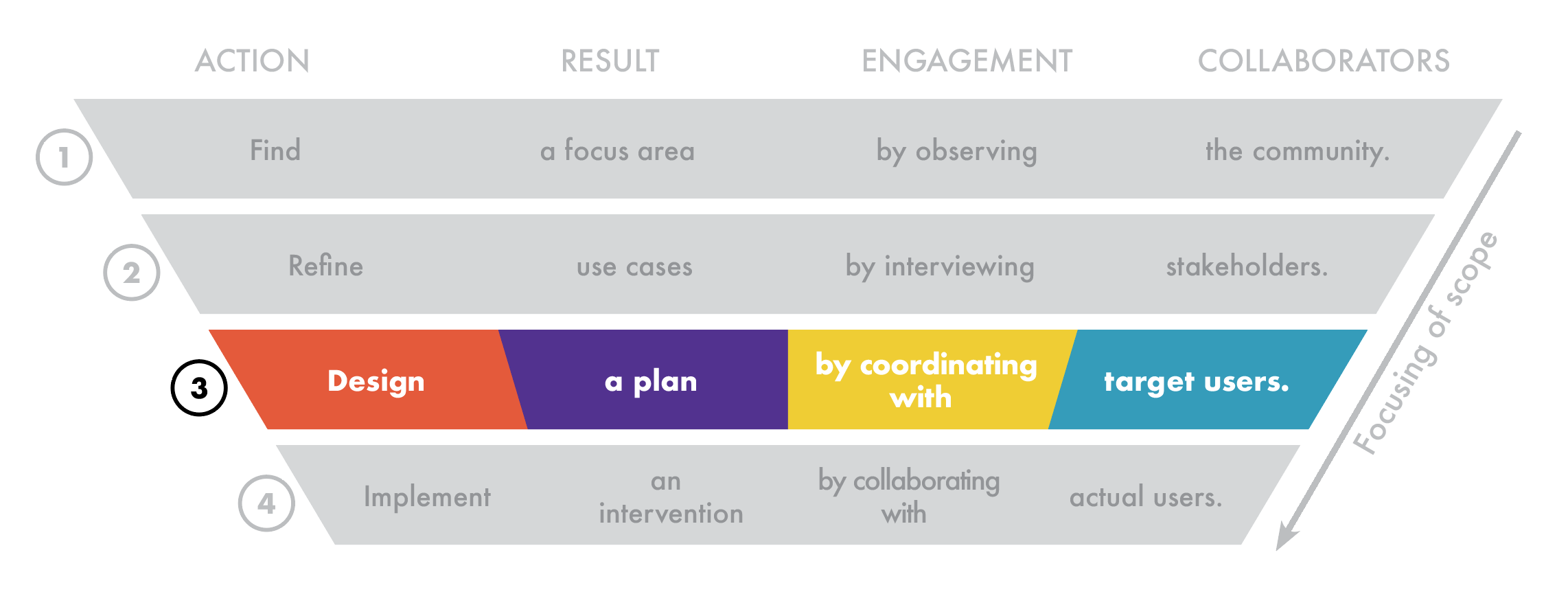Step 3: Design
- THE ACTION: Select a single use case, and draft a plan for an intervention to support that use case.
- THE ENGAGEMENT: Share a draft plan and ask for feedback through multiple avenues.
- THE COLLABORATORS: Intended users of open data, based on the target audience for a specific intervention to support your chosen open data use case.
- THE RESULT: A user-informed plan that outlines an intervention to actively support and facilitate your chosen open data use case.
Examine your use cases from Step 2 and select a single one that has the most potential for an effective intervention. Take into account both your capacity and stakeholder interest. Limiting the opportunities in this step is crucial for taking a tactical, focused approach to facilitating the community use of open data, one use case scenario at a time.
Narrow down which specific stakeholders will be the intended users of relevant data and work more closely with them to begin mapping interventions like products, projects, or tools. Note that you are not carrying out an intervention in this step, but rather putting together a plan that you will carry out. Review the implementation tactics in Step 4 so you can plan ahead accordingly. The plan generated in this step should outline the intervention that supports your chosen use case, and should feature feedback from intended users on how they would like to be incorporated.
Planning alongside the your intended users entails either collaboratively drafting a plan or soliciting feedback on a draft plan and incorporating responses. Collaborative planning with the intended data users in your community is essential for ensuring that planned interventions address exactly what data users need and account for details of implementation, for example, ensuring that the community agrees on who should house the project or sustain it once the government’s role is complete. A plan that hasn’t been reviewed by residents is less likely to be effective. “How formal does my plan need to be?” It depends on your context. In a community that has already had lots of conversations about open data and shared goals, a short back and forth over email or an in-person conversation at a community meeting might be enough. In a community where there is less common understanding, you will probably need to do more work building consensus. The idea of Tactical Data Engagement is to focus on a specific end goal — use your judgment about how to best achieve that.
Tactics to help you design a plan:
| TACTIC | DESCRIPTION |
|---|---|
| Solicit user feedback | Using crowdsourced policy feedback as a model, for example, post your draft plan in the open and solicit feedback from your intended, primary audience. Solicit comments on the plan through digital tools and update the draft accordingly. |
| Hold expert focus groups | Convene a user group meeting with local experts or data users to generate input on whether roles, timelines, and activities are appropriate for your desired outcomes. Invite your intended community data users to comment on a draft plan or collaboratively draft an action plan based on their experience in the field. Solicit in-person, detailed input pertaining to subject matter and the feasibility of your shared, desired outcomes. |
| Host public planning workshops | Invite the broader public to a community meeting where the main activity will include a low-tech engagement activity like note card sorting, diagramming, or collecting sticky note feedback on how your agency should proceed with addressing your specific opportunity for community use of open data. Commit to implementing feedback gathered at public meetings and express next steps. |